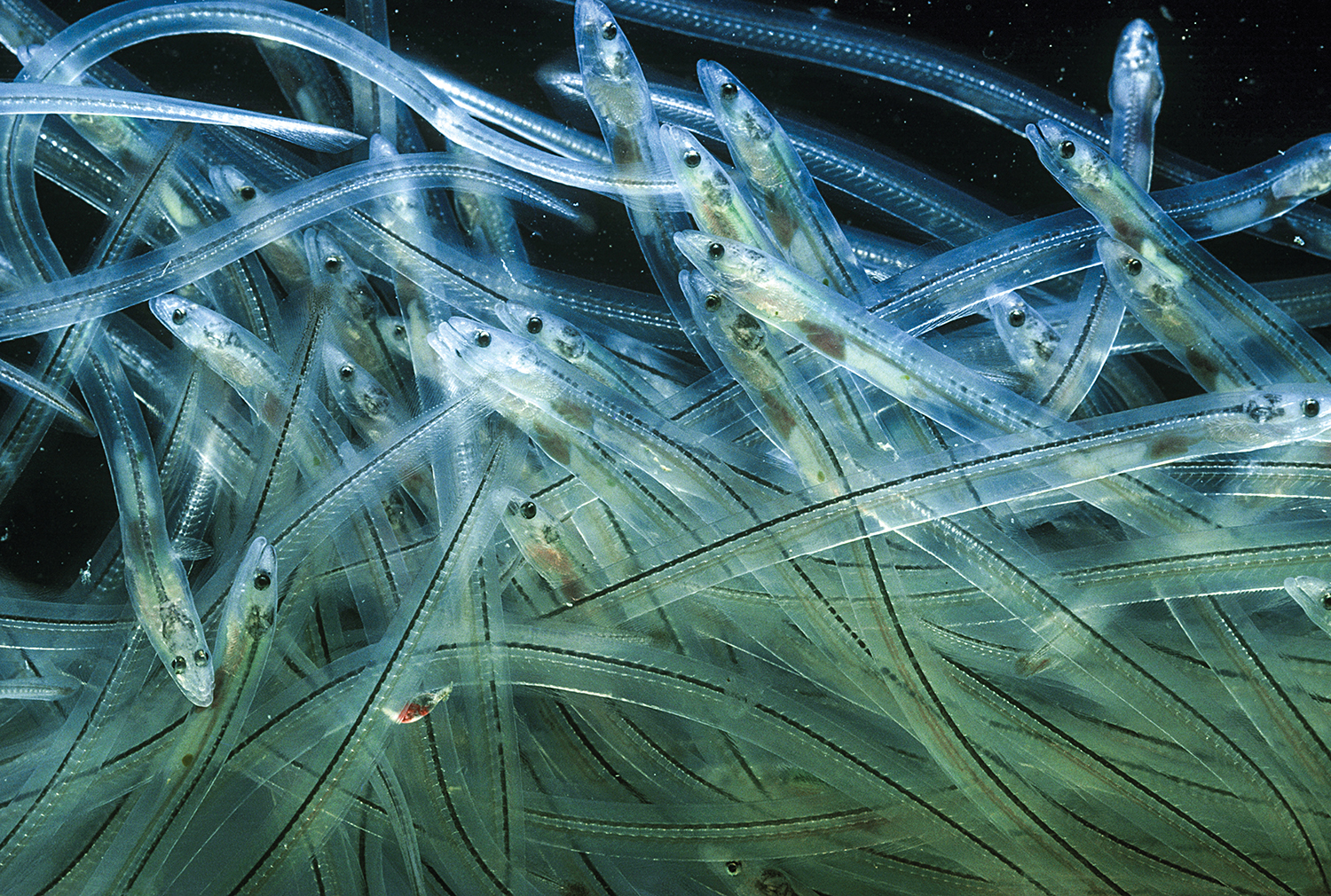The Eels Must Have GPS, But Where Are They Hiding It?
Posted on Nov. 10, 2017
Glass eels, transparent except for a spine, have a much longer commute than they did when the continents were closer together. (Philippe Garguil/Science Source)
They’re the size of your pinky and transparent as glass, yet baby European eels travel more than 3,700 miles from their spawning ground deep in the Bermuda Triangle to rivers and streams and lakes from North Africa all the way to Scandinavia. They spend 10 to 15 years feeding and growing in lakes and streams before swimming all the way back to the Sargasso Sea.
The migration is a vestige of an era when the continents were just tens of miles apart. As the continents have drifted, the commute has become almost unfathomably long.
The question of where they come from and how they navigate has mystified scientists since the days of Aristotle, who surmised that they sprang unbidden from the mud. More recently, scientists believed that eel larvae floated passively into the Gulf Stream and let the current carry them across to Europe. Now a team led by a UNC researcher has shown that glass eels read the Earth’s magnetic field and swim deliberately into the current.
Prior to this study, it was known that loggerhead turtles use magnetoreception to navigate. The only fish species known to do so was the chinook salmon, but these findings suggest that more species may find their way across the ocean floor by reading magnetic fields. The knowledge will help in fisheries management. It also has caught the eye of the Air Force, which is looking at the Earth’s magnetic field as a potential navigation tool for its jets.
“What’s exciting is that we’ve had two iconic marine migrants with pretty much the same mechanism for finding their way around,” says Catherine Lohmann, a researcher in UNC’s biology department who studies marine animals. “Now we have a third, and this starts making it a trend. Magnetic navigation might actually be the main thing that marine animals use to guide themselves, and it might even be important for terrestrial animals and birds.”
Lewis Naisbett-Jones, now a doctoral candidate in marine biology at UNC, was at Aberystwyth University in Wales, where he worked with Nathan Putman ’11 (PhD). Putman’s expertise was in salmon. They wondered whether magnetoreception would explain eels’ behavior, too.
So Naisbett-Jones bought thousands of glass eels and placed them, 16 at a time, into tanks with 12 spoke-like chambers, each at a precise 30-degree angle to the next. The tanks were surrounded by a scaffolding of wires shot through with electric current in a way that mimicked the magnetic grid at three points along the journey from the Sargasso Sea to Europe.
“Each location on Earth is delineated by a different combination of intensity and angle at which the magnetic field intersects the surface of the Earth,” Naisbett-Jones said, “and both of those components change over the surface of the Earth, creating a bi-coordinate map that serves as the animals’ GPS.”
In his experiments, the eels were placed in the center of the maze, all of the exits blocked by moveable doors. When he set up the magnetic field to mimic that of the Sargasso, the eels oriented themselves southwest, which seemed counterintuitive to the land-living scientists. Why would they go southwest when their goal is to end up in streams to the north and east?
So Putman plugged their data into a computer simulation of the gyres within the ocean, and suddenly it made sense: The eels were following their magnetic map to the Antilles Current, which whisked them into the swift Gulf Stream and gave them a nearly free ride northeast.
“I’m sort of embarrassed to say that we assumed they would go north,” Putman said. “It doesn’t matter to them what the shortest distance between two points is as a crow flies, because they’re not crows and they’re not flying. It makes sense to go where you can catch a current.”
One theory of how these animals navigate involves a chain of magnetically sensitive crystals made of iron, which already has been found in bacteria and some animals. But no one knows whether the crystals matter in navigation, nor where in an eel or turtle — or even a human — the crystals would be. The magnetic field passes freely through all earthly bodies, but how, and where in their bodies, is not known.
“The three main things we don’t know are where the magnetic receptors are located, the underlying genetics, and how it varies through life stage,” Naisbett-Jones said. He spent the summer studying chinook salmon in Oregon and turtles in Costa Rica. He returned to his eels — and the classroom — this fall, but his eyes already are on next summer’s adventures.
His eel navigation research got a deluge of media coverage, including from National Public Radio. “It got a lot more press than I was ever expecting. I didn’t expect my first paper to be so exciting.”
— Janine Latus
Thanks for reading the Carolina Alumni Review
Carolina Alumni members, sign in to continue reading.
Not yet a member? Become one today.
